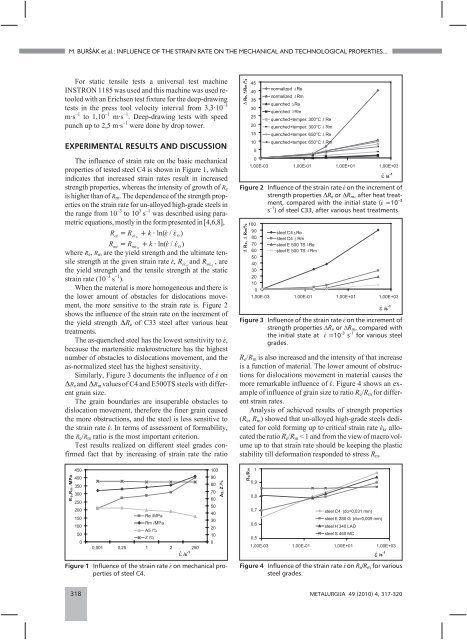PDF - 3756 kB - CARNet
PDF - 3756 kB - CARNet
PDF - 3756 kB - CARNet
Create successful ePaper yourself
Turn your PDF publications into a flip-book with our unique Google optimized e-Paper software.
M. BUR[ÁK et al.: INFLUENCE OF THE STRAIN RATE ON THE MECHANICAL AND TECHNOLOGICAL PROPERTIES...<br />
For static tensile tests a universal test machine<br />
INSTRON 1185 was used and this machine was used retooled<br />
with an Erichsen test fixture for the deep-drawing<br />
tests in the press tool velocity interval from 3,3·10 –3<br />
m·s –1 to 1,10 –1 m·s –1 . Deep-drawing tests with speed<br />
punch up to 2,5 m·s –1 were done by drop tower.<br />
EXPERIMENTAL RESULTS AND DISCUSSION<br />
The influence of strain rate on the basic mechanical<br />
properties of tested steel C4 is shown in Figure 1, which<br />
indicates that increased strain rates result in increased<br />
strength properties, whereas the intensity of growth of Re<br />
is higher than of Rm. The dependence of the strength properties<br />
on the strain rate for un-alloyed high-grade steels in<br />
the range from 10 –3 to 10 3 s –1 was described using parametric<br />
equations, mostly in the form presented in 4,6,8,<br />
Re Re k ln( / )<br />
0<br />
0<br />
Rm Rm k ln( / )<br />
0<br />
0<br />
where Re, Rm are the yield strength and the ultimate tensile<br />
strength at the given strain rate , R and R , are<br />
e0 m0<br />
the yield strength and the tensile strength at the static<br />
strain rate (10 –3 s –1 ).<br />
When the material is more homogeneous and there is<br />
the lower amount of obstacles for dislocations movement,<br />
the more sensitive to the strain rate is. Figure 2<br />
shows the influence of the strain rate on the increment of<br />
the yield strength Re of C33 steel after various heat<br />
treatments.<br />
The as-quenched steel has the lowest sensitivity to ,<br />
because the martensitic makrostructure has the highest<br />
number of obstacles to dislocations movement, and the<br />
as-normalized steel has the highest sensitivity.<br />
Similarly, Figure 3 documents the influence of on<br />
Reand Rmvaluesof C4 and E500TS steels with different<br />
grain size.<br />
The grain boundaries are insuperable obstacles to<br />
dislocation movement, therefore the finer grain caused<br />
the more obstructions, and the steel is less sensitive to<br />
the strain rate . In terms of assessment of formability,<br />
the Re/Rm ratio is the most important criterion.<br />
Test results realized on different steel grades confirmed<br />
fact that by increasing of strain rate the ratio<br />
Figure 1 Influence of the strain rate on mechanical properties<br />
of steel C4.<br />
Figure 2 Influence of the strain rate on the increment of<br />
strength properties Re or Rm, after heat treatment,<br />
compared with the initial state ( =10 –3<br />
s –1 ) of steel C33, after various heat treatments.<br />
Figure 3 Influence of the strain rate on the increment of<br />
strength properties ÄRe or ÄRm, compared with<br />
the initial state at =10 -3 s -1 for various steel<br />
grades.<br />
Re/Rm is also increased and the intensity of that increase<br />
is a function of material. The lower amount of obstructions<br />
for dislocations movement in material causes the<br />
more remarkable influence of . Figure 4 shows an example<br />
of influence of grain size to ratio Re/Rm for different<br />
strain rates.<br />
Analysis of achieved results of strength properties<br />
(Re, Rm) showed that un-alloyed high-grade steels dedicated<br />
for cold forming up to critical strain rate kr allocated<br />
the ratio Re/Rm < 1 and from the view of macro volume<br />
up to that strain rate should be keeping the plastic<br />
stability till deformation responded to stress Rm.<br />
Figure 4 Influence of the strain rate on Re/Rm for various<br />
steel grades.<br />
318 METALURGIJA 49 (2010) 4, 317-320
















